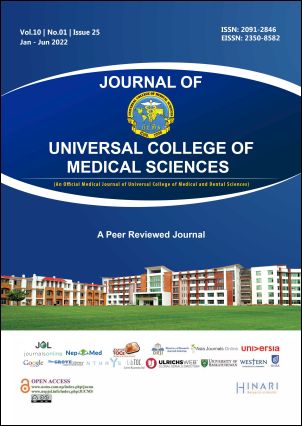Clinical Profile and Outcome in Patients with Organophosphorous Poisoning
DOI:
https://doi.org/10.3126/jucms.v10i01.47149Keywords:
Organophosphorus, Suicicide, PoisoniningAbstract
INTRODUCTION
Organophosphorous poisoning is a prevalent emergency care problem found in Nepal. Nepal being agricultural country and pesticide being easily available, organophorous poisoning is most common cause of poison related morbidity and mortality in Nepal. Main objective of the study is to evaluate the clinical profile and outcome of patients on the basis of demographic profile, type of compound, presenting symptoms and outcome.
MATERIAL AND METHODS
Our study included 80 patients with organophosphorous ingestion, admitted in ICU and wards of Universal College of Medical Sciences Teaching Hospital (UCMS-TH), Bhairahawa, Rupendehi, Nepal from1th July, 2019 AD to 30th July 2020 AD. Ethical clearance was obtained along with consent from patient. Data was collected from patient’s visitor.
RESULTS
Females (63%) were more common than males (37%). Age group 21-30 was most likely to ingest OP compound for suicidal attempts.Chlorpyriphos (80%) was most common compound ingested.41% cases consumed alcohol, 10% cases were smokers, 11% cases had diabetes and 22% cases had hypertension. Vomiting (90% cases) was most common symptom. 54% cases had hospital stay of less than 5 days and 43% cases had hospital stay of 5-10 days.Based on POP scoring 24 cases of moderate severity 1 case died where as 3 cases out of 8 severe cases died.74% had uneventful recovery,11% developed intermediate symptoms,10% needed ventillatory support and 5% died due to poisoning.
CONCLUSION
Organophosphorous poisoning was the most common acute poisoning in young female population.Strict policies against the free availability and sale of insecticides is required to control organophosphorus poisoning.
Downloads
Downloads
Published
How to Cite
Issue
Section
License
Copyright (c) 2022 Journal of Universal College of Medical Sciences

This work is licensed under a Creative Commons Attribution-NonCommercial 4.0 International License.
Authors have to give the following undertakings along with their article:
- I/we declare that this article is original and has not been submitted to another journal for publication.
- I/we declare that I/we surrender all the rights to the editor of the journal and if published will be the property of the journal and we will not publish it anywhere else, in full or part, without the permission of the Chief Editor.
- Institutional ethical and research committee clearance certificate from the institution where work/research was done, is required to be submitted.
- Articles in the Journal are Open Access articles published under the Creative Commons CC BY-NC License (https://creativecommons.org/licenses/by-nc/4.0/)
- This license permits use, distribution and reproduction in any medium, provided the original work is properly cited, and it is not used for commercial purposes.




